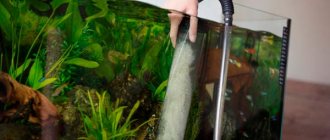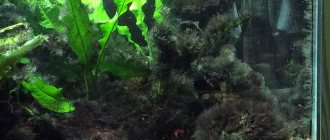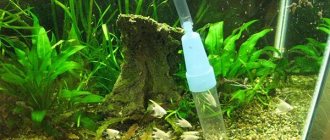The sacbranch catfish (lat. Heteropneustes fossilis) is an aquarium fish that comes from the sacbranch family.
This is a large (up to 30 cm), active predator, and even poisonous. Fish of this genus have two bags instead of lungs, running along the body from the gills to the tail itself. When the catfish reaches land, the water in the bags allows it to survive for several hours.
Habitat in nature
It occurs quite often in nature, distributed in Iran, Pakistan, India, Nepal, Sri Lanka, and Bangladesh.
It is found in places with weak currents, often in stagnant water with excess oxygen - swamps, ditches and ponds. It can go into rivers and has even been seen in salt waters.
Also known in the West as the stinging catfish, the sacbranch is not recommended for beginner aquarists due to its toxicity.
The poison is contained in sacs at the base of the chest spines.
The sting is very painful, resembles a bee sting and in some cases can cause anaphylactic shock.
Naturally, you need to be extremely careful when cleaning the aquarium or catching fish.
In case of a bite, the affected area should be immersed in as hot water as possible to coagulate the protein in the poison and consult a doctor.
Home maintenance
To keep such an unusual fish in a home aquarium, you must adhere to the following recommendations:
- The sacbranch catfish adapts to the size of its surroundings. Therefore, the capacity of the aquarium does not matter much.
- The water in the aquarium should be from +21 to +25 degrees.
- It is better to place the aquarium in a dark place and put several shelters in it where the catfish can hide (see photo). But you shouldn’t clutter the bottom too much; the catfish hunts at night and needs enough space for this. The presence of algae is also desirable.
- The lighting of the aquarium should not be bright.
- Catfish have delicate skin, so objects with sharp edges should not be in the water.
- It is better to put a lid on the aquarium, because the catfish is able to get to the surface.
- The fish are very active, they are large and leave a lot of waste. This assumes having a powerful filter and changing the water 1-2 times a week (replacing 15% of the total water volume).
- There are no special nutritional requirements, since the sacbranch catfish eats any animal food: worms, fish fillets, meat, shrimp, etc. Frozen dry food is also suitable.
- Pieces of food should be small, because the catfish swallows the food completely. Large pieces can harm his health.
Description
The habitat has left its mark on the catfish. It can survive in conditions where there is very little oxygen in the water, but it needs access to the surface where it can breathe.
In nature, catfish can leave a body of water and move overland to another. The structure of the lungs and abundant mucus help him in this, making it easier to move.
In nature it grows up to 50 cm long, in aquariums it is much smaller, no more than 30 cm.
The body is elongated, laterally compressed. The belly is rounded. There are four pairs of whiskers on the head - on the lower jaw, nasal and upper jaw. Long anal fin with 60-80 rays, lateral fins 8 rays.
The lifespan of the sacbranch catfish is 5-7 years; how long they live largely depends on the conditions of detention.
Body color ranges from dark to light brown. Albino is very rare, but is found on sale. Its conditions of detention are the same as usual.
Reproduction at home
Reproduction in an aquarium is possible, but only after aquarium sacbranch catfish reach the age of two years. Sex is usually determined by the size of the fish. Females are somewhat smaller. In order for a couple to begin to reproduce:
- It is necessary to transplant mature individuals into a fish tank; it should be shallow with a soft sandy bottom.
- The water temperature is increased by a couple of degrees and an injection of Gonadotropin is administered, for the female this is an impetus for spawning.
- Egg laying occurs at dusk, up to 5 thousand eggs at a time.
- In the morning, the pair must be returned to the common aquarium, otherwise they may eat most of their offspring.
- The fry appear a day later. They are fed live dust and yolk. A week later, crushed live food is introduced: bloodworms, daphnia, tubifex.
It is important to closely monitor the maturation of the offspring, because brothers and sisters grow unevenly. Larger individuals are capable of harming their relatives, so periodically it is necessary to carry out an inspection and place the grown-up children in a common aquarium.
Keeping in an aquarium
Best kept in semi-darkness with plenty of hiding places, but also an open area for swimming. There should be no sharp edges in the aquarium, as the fish have delicate skin.
The aquarium must be closed, since the sacbranch catfish can get out even through a small hole in search of new bodies of water.
The fish is active and produces a lot of waste, so the aquarium needs strong filtration. For the same reason, frequent water changes are needed.
Predators go out hunting at night, so you can’t keep them with fish that they can swallow. And given their considerable size, the best neighbors for them are large catfish and cichlids.
They are unpretentious in nutrition and maintenance; they eat any animal food; you can also add worms to the diet.
Water parameters: pH: 6.0-8.0, hardness 5-30°H, water temperature 21-25 °C
Keeping the sacbranch catfish
The sacbranch catfish cannot be called a fastidious fish. During the day, most often it hides in shelters or lies motionless on the bottom; make sure that your aquarium has a sufficient number of stones, snags and caves. The volume of the aquarium can vary from 100 liters or more. It is advisable that the fish have enough space to swim.
photo: Sacbranch catfish can live in artificial conditions for up to 12 years
As for water parameters, maintain the temperature at 21-25 degrees, hardness can reach 20°, pH slightly above neutral - 6.5-7.5. The aquarium must be equipped with a filter and an aeration system. You also need to change the water on time: replace about a quarter of the water with fresh water weekly. It is advisable to cover the aquarium with a lid: if a catfish accidentally jumps out, it can survive without water for a couple of hours, but nothing can save it from damage due to a fall from a height.
When choosing soil, pay attention to small pebbles; a layer 1.5-2 centimeters thick is enough. The fish likes lighting that is weak and diffused; in the morning, the aquarium can be placed near the window, and then slightly shaded. When catching a sacbranch catfish with a net, you need to be careful. This is a non-aggressive fish, but if attacked, it will defend itself with poisonous spines.
As for feeding, these aquarium inhabitants are quite voracious, so they consume both live food and artificial substitutes. From live food, you can give catfish pieces of shrimp, fish, scraped meat, etc. The fry begin to be fed with brine shrimp.
Compatibility
A predator, and a very skillful one at that! Very often it is sold as a harmless fish that can be kept in a community aquarium.
But, the sacbranch is not at all suitable for general aquariums. And then the aquarist wonders where his neons disappear to.
It is very simple to understand whether a fish is compatible with a sacbranch - if it can swallow it, then no.
He needs to be kept with fish that are large enough that he simply has no chance of eating them. Most often it is kept with large cichlids.
Breeding sacbranch catfish
Sexual maturity in sacbranch catfish occurs at 1.5-2 years. During spawning, you can see characteristic color changes: from monochromatic it becomes spotted. In aquariums, independent reproduction is impossible, so aquarists often resort to the method of pituitary injections.
The minimum volume of the spawning tank is from 100 liters, a spawning grid is laid on the bottom, covered with small-leaved plants, and several shelters must also be placed. The water temperature rises gradually to 27-29 degrees, and this will become an additional stimulation for spawning. Carbonate hardness should be minimal - up to 10°, pH 7.0.
Males, unlike other species, do not build nests for eggs; females throw them in piles. At one time, the female lays up to 500 pieces of yellowish eggs, which the male fertilizes. It is better to remove the parents after spawning and then replace a quarter of the water. The incubation period lasts a day, after which the larvae are born. Whitened unfertilized eggs must be removed in a timely manner. The fry begin to feed and swim after 3-4 days. Small catfish have a disproportionately large head and bear little resemblance to their parents until they grow to 5 centimeters. In the first days of life, the fry do not have additional respiratory organs, so the water level in the spawning tank should not exceed 20 centimeters. Gradually, babies are transferred to larger foods. Catfish can grow unevenly, so it is advisable to remove large individuals in time to avoid territorial fights and eating small counterparts.
(Visited 85 times, 1 visits today)
General information
The sacbranch catfish (Heteropneustes fossilis) is a large bottom-dwelling fish that can grow up to 35 cm in length in a suitable volume. The species received its name for its paired auxiliary respiratory organs - cylindrical sacs located along the body from the gills to the tail. Some researchers believe that they are filled with air, which the fish use as needed, others believe that inside the bags there is water that moisturizes the gills. Together with a large amount of mucus secreted by the skin of fish, this adaptation allows them to survive without water for up to several hours.
The venom of sacbranch owls is toxic to humans, but painful and reminiscent of a bee sting. However, people prone to allergies should be wary, because catfish venom can cause a serious allergic reaction. Therefore, any manipulations in the aquarium must be carried out while observing safety precautions. If you pull the fish to the surface, you can sometimes hear a characteristic squeak.
We invite you to familiarize yourself with what kind of fish is found in the Black Sea: list and fishing features
Compatibility of the sacbranch catfish with other fish
The sacbranch catfish coexists with similar-sized or larger and more active species. The small inhabitants of the aquarium will undoubtedly be eaten. Large characins and cyprinids, which occupy areas other than catfish in the aquarium (surface and thickness), are ideal. Bottom-dwelling and slow-moving fish will experience stress from cohabitation with sacbranch catfish because the latter is active at night. Surprisingly, these catfish of this species coexist perfectly in groups, i.e. are social.
We suggest you familiarize yourself with: Sacbranch catfish maintenance, compatibility, breeding, feeding
Diseases Individuals of Heteropneustes fossilis sometimes develop swim bladder disease. As a rule, it occurs in catfish farms or in an aquarium, where oxygen is supplied under pressure and the water is saturated beyond normal. The first symptom is a tilted body position and an upper bend in the tail area. There are bulging eyes and air blisters on the fins and other parts of the body.
The compatibility of this type of catfish depends on the nature of the fish. Some individuals get along well with guppies and other small fish, as well as with larger and more aggressive predators. Other sacbranch catfish eat or try to eat all the fish around them, or, on the contrary, hide in fear from cichlids or Angolan catfish.
- angelfish;
- mastacembel thai;
- labeo;
- large cichlids;
- large catfish;
- iris;
- knife fish;
- gourami;
- polypterus;
- large barbs.
The compatibility of this predator is often determined simply: if the fish is smaller in size and he can swallow it, then they cannot be kept together.











